The digital path to growth – CAD solutions and vision by Jayesh Halgekar

Today @AuManufacturing’s editorial series – the digital path to growth – looks further than IT infrastructure. Here Jayesh Halgekar argues that digitisation is a mindset.
Pre COVID-19 many businesses were considering or already enroute to reap the benefits of going digital.
The pandemic has fuelled the need for digital transformation, and not just in the manufacturing industry.
As we moved further into the pandemic, the gap has widened between those that had already embraced digital and those who had not.
The latter have also found themselves less prepared to adapt to the sudden changes brought about by the pandemic and many even succumbed to the vulnerability.
Digital Transformation is about connecting, extracting and integrating data digitally across all areas of a business, to evolve business processes and enhance the value to be delivered to their customers.
It refers to the transformation of business and organisational activities, systems, competencies, and models to extract maximum value out of digital technologies to have quicker, error-free and sustainable outcomes.
But when talking about it, business leaders often resort to discussing IT infrastructure, software technologies and applications. That is only part of the equation.
Digital transformation is a mindset, not just new technology.
Digital transformation is a mindset, not just new technology. While infrastructure and technology are important considerations, digital transformation requires a vision and a goal along with a willingness across the organization to embrace an evolving culture and upskilling.
For some, the aim may be to simply automate lengthy manual processes. Automating activities that previously took hours, days or even weeks to accomplish to be achieved in a fraction of the time.
While for others the goal may be to transform into a smart factory with systems digitally connected to machines that can monitor, learn, adapt, and self-optimise.
Each business is unique with its own set of challenges, resources, and game plans. Hence the level of digitisation or automation that the business may consider adopting, will vary.
Just considering design activities for a manufacturing company as an example, some businesses would consider converting their 2D sketched printouts to 3D Models as digitisation.
Another may consider digital transformation as a setup of a system for automating the generation of commercial, technical and production files, integrating with third party platforms, translating data to varied formats and communicating it across various channels to respective stakeholders.
A few may consider transforming the business to agile and self adapting smart factories by implementing AI, robotics and processing big data. It is all relative.
What Does This Mean For Manufacturers?
Markets are changing, and customers expectations from the products and services are soaring while prices are increasingly competitive.
Consumers want products faster, cheaper and easier than ever before, without a compromise on quality. Smart manufacturing is all about increasing throughput, uptime and performance while reducing overhead costs, operating costs and capital costs.
With a growing demand for personalisation and customisation, transforming from mass production to an industry characterised by mass customisation is the value-addition that is giving manufacturers an edge over competitors.
Design automation is enabling businesses to turn around proposals quickly, design and manufacture efficiently and deliver on promises consistently, all whilst maintaining a healthy profit.
By automating time-sensitive and often repetitive activities, businesses can focus on innovation and adding value to their products, improving throughput and quality to meet customers’ requirements. Most of the engineering design industry are using powerful CAD platforms merely as a production drawing creation tool.
Using a CAD program and adding all the metadata to these CAD models demands a lot of time and energy for creating the design data. Most often, this data is underutilised even after adding it to the models.
The first recommended step on the journey to digital transformation is to plan a staged approach. A Big Hairy Audacious Goal (BHAG) a.k.a “transformation” isn’t usually a plug and play solution.
Mapping out existing resources, budgets and realistic timelines can help identify the gap allowing you to list out immediate actions with relatively easily achievable milestones.
A design automation strategy alone can be applied at various levels of complexity based on already available resources.
What can we do with CAD for automation?
Almost every engineering design program out there has an open API that allows you to extract information and integrate the design systems with any of the above-mentioned systems.
Solid Vectors is working with Modsel, a manufacturer in the hospital and healthcare equipment sector to implement design automation software across their network of distributors globally.
Authorized personnel will be able to access an online configurator that allows their range of products and accessories to be individually customised to thousands of configurations via an interactive 3D model and submit fabrication data directly to the manufacturing facility in Queensland.
The system automatically generates 3D CAD files for all assemblies and parts, rendered images, picking lists, job sheets with unique Serial Numbers and eDrawing files, which are viewed by the fabrication, production and assembly teams directly on interactive screens.
All files are automatically checked into secure digital vaults.
The company’s vision was to immediately respond to each customers unique requirements and reduce the dependency of the production team on their design team by providing automated critical build information for these orders.
This allows the engineering design team to focus on new product development and other important engineering activities rather than underutilising their capability for updating drawings, documents and preparation of costings.

Jayesh Halgekar is an advocate for smarter engineering design systems, CAD automation and digital manufacturing. He co-founded Solid Vectors Pty Ltd and leads a team who help manufacturing companies derive maximum value for 3D CAD solutions.
Picture: Jayesh Halgekar
@AuManufacturing’s editorial series – the digital path to growth – is brought to you with the support of SAP enterprise application software.

Subscribe to our free @AuManufacturing newsletter here.
@aumanufacturing Sections
Analysis and Commentary Awards Defence Manufacturing News Podcast Technology Videos






